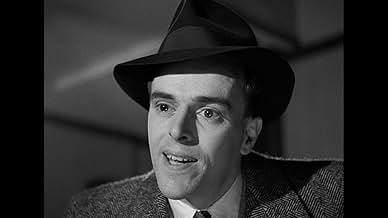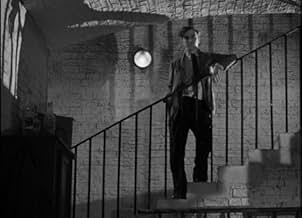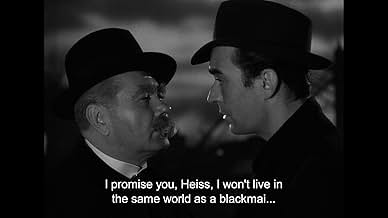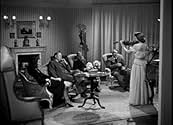Ajouter une intrigue dans votre langueIn Britain, a man with a shady past uses his antiquities shop as a front for smuggled diamonds but his young shop-assistant starts blackmailing him, leading to murder and to a police investi... Tout lireIn Britain, a man with a shady past uses his antiquities shop as a front for smuggled diamonds but his young shop-assistant starts blackmailing him, leading to murder and to a police investigation.In Britain, a man with a shady past uses his antiquities shop as a front for smuggled diamonds but his young shop-assistant starts blackmailing him, leading to murder and to a police investigation.
- Director
- Writers
- Stars
Arthur Dibbs
- Man at Auction
- (uncredited)
Diana Dors
- Mildred
- (uncredited)
Sam Harris
- Pubber
- (uncredited)
Katie Johnson
- Music Box Seller.
- (uncredited)
Vi Kaley
- Flower Seller
- (uncredited)
David Keir
- Gentleman Customer
- (uncredited)
James Knight
- Publican
- (uncredited)
Eliot Makeham
- Usher At Concert Hall
- (uncredited)
Avis en vedette
Oskar Homolka (Mr Heiss) owns an antique shop and is very proud of his violin-playing daughter Muriel Pavlow (Margaret) who is just breaking into the big time. Kenneth Griffith (Archie) is a slimy weasel who works in the shop and is attracted to Muriel. God knows why. She has a boyfriend in the Navy - Derek Farr (Robert) - and they are the rather bland goody-two-shoes couple. It is the other actors who give this film colour and the desire to see things through to the end. Griffith has a weasely plan to get one over Homolka.
One strange thing about the film was making Homolka a French citizen. No, he's not. What's the point in trying to pull that one off? Anyway, I'm not surprised at what he's up to with his antiques and when you have a character like the slimy Griffith as an assistant, then you are asking for trouble. Diana Dors (Mildred) has a memorable small role as a cheap girlfriend for Griffith. As does Katie Johnson as a customer in the shop - you'll recognize her from her pivotal role in "The Ladykillers" (1955).
One strange thing about the film was making Homolka a French citizen. No, he's not. What's the point in trying to pull that one off? Anyway, I'm not surprised at what he's up to with his antiques and when you have a character like the slimy Griffith as an assistant, then you are asking for trouble. Diana Dors (Mildred) has a memorable small role as a cheap girlfriend for Griffith. As does Katie Johnson as a customer in the shop - you'll recognize her from her pivotal role in "The Ladykillers" (1955).
Oscar Homolka is super in this crafty little crime noir. He portrays a reputable antiques dealer whose daughter "Margaret" (Muriel Pavlow) is a virtuoso violinist. Unbeknown to all, though, he also has another business fencing stolen jewellery with his friend Derek Farr. When his odious clark "Morris" (Manning Whiley) overhears one of their conversations and tries his hand at a little blackmail, things start to spiral out of control as he threatens to tell the young woman of her father's behind-the-scenes shenanigans. When he demands that he be allowed to marry her - well you can guess! George King keeps the pace of this moving along well, with Whiley really good as the scheming underling whose looming comeuppance is surely just a matter of time. The score - especially the Mendelssohn Violin concerto at the end, adds loads to the atmosphere of this superior thriller that has plenty to shout about. Rarely seen these days, but if you do come across it - give it a watch, it's a more substantial part for the star that is well worth a watch.
This is a most enjoyable film classic in the vintage 1940s tradition. The opening segment, as the credits fade out against the backdrop of a cold, dark, night correlate with the sense of mystery and intrigue suggested in the title. There's something warm and inviting, here for the aficionado.
Although shot in 1947, the film has a familiar Dickensian feel to it; there's the antique store that features as the central setting (shades of "The Old Curiosity Shop"), there's Kenneth Griffith who lurks ominously like Uriah Heep (from "David Copperfield" and Kathleen Harrison, that perennial favourite, is the archetypal Victorian housekeeper. Muriel Pavlow's character, although not fully explored, has some resemblance to a Dickensian heroine.
Thickly moustachioed, Oskar Homolka (cigar-puffing, piercing eyes and busy eyebrows), in the role of protagonist, delivers a masterful performance (can one ever forget him after watching him in whichever role he plays?). He and Griffith are the driving forces that propel this absorbing drama. For one relatively new to acting, Griffith delivers a convincing performance. Beneath the superficial layer of criminal activity, the film goes deeper to touch on, among other issues, the nature of evil which in Griffith's case appears to be an inherent trait. In the case of Homolka: is he a tragic figure, does he evoke a sense of pathos, does he earn our sympathy? These are some of the questions which the view faces at the film unfolds.
The 1940s was the highpoint in British cinema and it's not difficult to see why this film is so highly rated in the canon.
PS: If you are a lover of classical music, you will enjoy a bonus!
Although shot in 1947, the film has a familiar Dickensian feel to it; there's the antique store that features as the central setting (shades of "The Old Curiosity Shop"), there's Kenneth Griffith who lurks ominously like Uriah Heep (from "David Copperfield" and Kathleen Harrison, that perennial favourite, is the archetypal Victorian housekeeper. Muriel Pavlow's character, although not fully explored, has some resemblance to a Dickensian heroine.
Thickly moustachioed, Oskar Homolka (cigar-puffing, piercing eyes and busy eyebrows), in the role of protagonist, delivers a masterful performance (can one ever forget him after watching him in whichever role he plays?). He and Griffith are the driving forces that propel this absorbing drama. For one relatively new to acting, Griffith delivers a convincing performance. Beneath the superficial layer of criminal activity, the film goes deeper to touch on, among other issues, the nature of evil which in Griffith's case appears to be an inherent trait. In the case of Homolka: is he a tragic figure, does he evoke a sense of pathos, does he earn our sympathy? These are some of the questions which the view faces at the film unfolds.
The 1940s was the highpoint in British cinema and it's not difficult to see why this film is so highly rated in the canon.
PS: If you are a lover of classical music, you will enjoy a bonus!
I finally caught this film on an ebay DVD copy which was OK quality but not top notch. I'd read Muriel Pavlow's interview by Brian McFarlane which mentioned this film and her role in it and so i was interested to see it. This is the film on which she met her future husband actor Derek Farr and admits she was upstaged by Oscar Homolka every which way. Homolka is the heart and guts of this film and he is superb. Kenneth Griffith( he played the same role in the stage production) also shines and once he disappears from the action the film is not so gripping. There is an effective twist in the tale/tail and it is a surprisingly downbeat story overall with its insights into the less savoury side of human character.
I expected this movie to be oldfashioned in acting style with an easy plot. Instead it surprised me with a fairly complex plot and some actions by the characters I did not foresee. Most important, I thought the acting style of Homulka was extremely "real," and he did not sound like he was speaking lines. Take yourself back to the 30s --which is what it looked like, even if it is 1947, and enjoy.
Le saviez-vous
- AnecdotesThis was Diana Dors' first film.
- GaffesDescius Heiss is supposed to be French, although the name is not French, and Oscar Homolka does not use a French accent.
- ConnexionsFeatured in Diana Dors: Britain's Blonde Bombshell (2022)
- Bandes originalesAve Maria
(uncredited)
Music by Franz Schubert
Arranged by George Melachrino
Performed by Frederick Grinke (solo violin)
Meilleurs choix
Connectez-vous pour évaluer et surveiller les recommandations personnalisées
- How long is The Shop at Sly Corner?Propulsé par Alexa
Détails
- Date de sortie
- Pays d’origine
- Langue
- Aussi connu sous le nom de
- Code of Scotland Yard
- Lieux de tournage
- société de production
- Consultez plus de crédits d'entreprise sur IMDbPro
- Durée1 heure 31 minutes
- Couleur
- Mixage
- Rapport de forme
- 1.37 : 1
Contribuer à cette page
Suggérer une modification ou ajouter du contenu manquant

Lacune principale
By what name was The Shop at Sly Corner (1947) officially released in India in English?
Répondre































